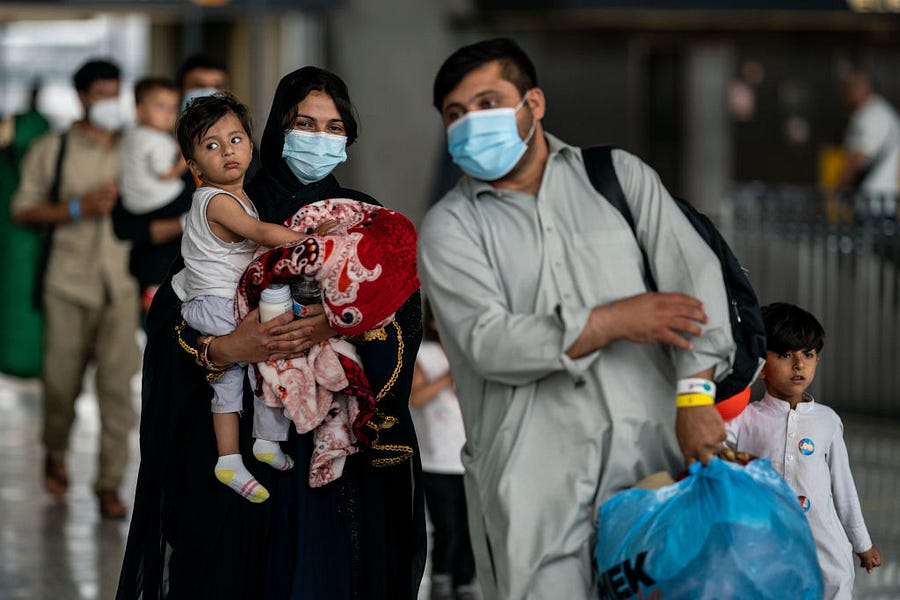On the day of the United States’ self-imposed deadline to pull troops from Afghanistan, President Joe Biden took the podium in the White House’s State Dining Room to declare an end to a two-decade war.
“We completed one of the biggest airlifts in history, with more than 120,000 people evacuated to safety,” the president said. “Only the United States had the capacity and the will and the ability to do it, and we did it today.”
The previous day, CENTCOM Commander Gen. Kenneth McKenzie had the less desirable task of informing Americans of the withdrawal’s logistics—what the mission did and did not achieve. When the final manned aircraft departed Hamid Karzai International Airport (HKIA) just after midnight Kabul time, McKenzie said, it brought with it the remnants of Afghanistan’s U.S. military presence.
But “hundreds” of Americans, many more green card holders, and tens of thousands of the U.S.’s Afghan partners seeking to leave the country remain, with a scantily articulated plan for getting them out.
“A new diplomatic mission has begun,” Secretary of State Antony Blinken declared on August 30, without elaborating on the soft power tools at the U.S.’s disposal as it negotiates with the Taliban. The State Department employed a similar line to explain why the jihadist group wouldn’t take the country by force, citing Taliban concern about international legitimacy even as it closed in on Afghanistan’s provincial capitals last month.
And Taliban leadership promises to extend political amnesty to those left behind already ring hollow amid an outpouring of reports of politically motivated arrests and extrajudicial executions. Several sources tell The Dispatch that Afghan interpreters, translators, and their families are in hiding in Kabul after being told to await instructions from the U.S. Embassy to travel to the airport.
Amid the Biden team’s dereliction of its duty to protect Americans and its Afghan partners, thousands of volunteers, former government officials, journalists, and veterans have stepped up to patch holes in the U.S. evacuation plan. The collective efforts, dubbed “Digital Dunkirk” in reference to the 1940 evacuation of Allied forces during World War II, include both established nonprofit organizations and private citizens who moved to act as the Taliban closed in on Kabul.
Digital Dunkirk is a bit of a misnomer, given how many individuals put themselves in harm’s way to make it happen. In the weeks leading up to the fall of Afghanistan’s capital, teams working from afar and on the ground dispatched buses to bring Americans and Afghans to the airport, funded and organized charter flights, and secured seats on commercial airliners en route to Istanbul, Dubai, and elsewhere. When U.S. troops assumed control of the evacuation efforts, volunteers shifted gears to focus on getting as many individuals and families through HKIA’s gates as possible before the military withdrawal.
Most of the Americans involved in the mission are driven by their personal connections to the Afghans whom they worked and fought alongside for two decades, against Islamist fighters whose brutality they understand more intimately than other non-Afghans.
The volunteers’ proximity to the crisis also positioned them to navigate evacuees through various obstacles en route to the airport. To get Afghans through Taliban checkpoints, volunteers called in favors from journalists with working relationships with the group. To get them through the gates of HKIA, contacts inside the U.S. military proved useful. To anticipate various security threats and get a clearer picture of the safest times and courses to travel, veterans and ex-officials pulled connections in what’s left of Afghanistan’s intelligence network.
Many longtime Washingtonians have access to all three, allowing them to work as intermediaries to facilitate communication and aid in transit across Kabul. But evacuation efforts were halted after an Islamic State suicide bombing in crowds surrounding the airport killed 13 U.S. servicemembers and at least 170 Afghan civilians fleeing the Taliban. U.S. forces reportedly welded shut the gates enclosing HKIA following the blasts, leaving those outside stranded.
Speaking to Fox News Sunday over the weekend, Rep. Michael McCaul—the lead Republican on the Foreign Affairs Committee—claimed that six planes carrying Americans and Afghan interpreters remain grounded at Mazar-i-Sharif International Airport in northern Afghanistan at the Taliban’s request. Reuters later placed the number of would-be evacuees at more than 1,000. “We know the reason why is because the Taliban want something in exchange,” McCaul said, alluding to the prospect of a hostage crisis.
In the military evacuation’s aftermath, the non-governmental groups have continued their operation by communicating with Afghans in hiding, bringing media attention to their plight, and brainstorming alternate routes out of the country. But one nonprofit group, No One Left Behind, has been alerting the U.S. government of fatal flaws in its Special Immigrant Visa (SIV) application system since its conception in 2009.
“We’ve been advocating for process changes to the SIV program, which is currently a 14-step program, through three administrations, seven congresses, seven secretaries of defense, and five secretaries of state. This is not a new issue,” said James Miervaldis, a U.S. Army veteran and current chairman of No One Left Behind. “It has always been an afterthought in congressional appropriations, and these allies were, again, an afterthought in the evacuation plan.”
Most SIVs take more than 800 days to process. Last year, the State Department’s Office of the Inspector General published an audit including a series of recommendations to strengthen the SIV application process and shorten its time frame. The recommendations went unheeded.
Delays due to the coronavirus pandemic lengthened backlogs at the State Department, leaving thousands of visa-eligible Afghans in limbo amid the Taliban’s takeover, guilty by association with the U.S. but unable to draw on American support.
“They’re punished for following the law. They’re hunted by the Taliban, they have to deal with the bureaucracy for three and a half years, some are left behind,” Miervaldis told The Dispatch. “There’s just a very fundamental breakdown in government competency. If you look in the mirror of what the private sector is doing, versus what the government is doing, it’s really night and day.”
No One Left Behind continues its support for Afghan refugees when they reach U.S. soil. Last year, the organization helped more than 600 families in 93 cities across the country, providing $430,000 in direct financial assistance. Only 10 of those families came back for additional aid, Miervaldis said, citing a 2018 study by the Government Accountability Office that found that SIV recipients become self-sufficient at faster rates than other resettlement groups.
Elliot Ackerman, a former Marine Corps officer who served five tours of duty in Iraq and Afghanistan, became involved in behind-the-scenes efforts to evacuate Americans and Afghans when Kabul fell last month.
“I think it is remarkable that the government was unable to predict this and has been very, very slow in filling the gaps,” Ackerman told The Dispatch. “Even though individual citizens have done some pretty amazing things, and the Marines and service members on the ground did an amazing job in an incredibly difficult situation, the administration’s planning for this has been extremely lackluster. I hope they will start to do the work to follow through and do right in the long run.”
Between August 17 and August 31, State Department spokesman Ned Price touted last week, 31,107 evacuees arrived on U.S. shores. Fourteen percent were U.S. citizens, 9 percent were green card holders, and at least 77 percent—23,876 individuals—were Afghans at-risk.
But Price’s figures leave out a crucial piece of information. As of August 25, at least 250,000 American visa-eligible Afghans remained stranded in Afghanistan. Nearly 24,000 evacuations, while commendable, is a drop in the bucket of the Afghans and their families in immediate peril because of connections to the United States. Their fate now rests with the Taliban.







Please note that we at The Dispatch hold ourselves, our work, and our commenters to a higher standard than other places on the internet. We welcome comments that foster genuine debate or discussion—including comments critical of us or our work—but responses that include ad hominem attacks on fellow Dispatch members or are intended to stoke fear and anger may be moderated.
With your membership, you only have the ability to comment on The Morning Dispatch articles. Consider upgrading to join the conversation everywhere.